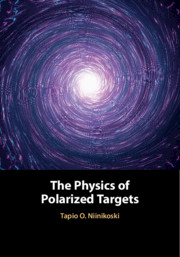Book contents
- The Physics of Polarized Targets
- The Physics of Polarized Targets
- Copyright page
- Dedication
- Contents
- Preface
- Acknowledgements
- 1 Introduction to Spin, Magnetic Resonance and Polarization
- 2 Resonance and Relaxation of Interacting Spin Systems
- 3 Electron Paramagnetic Resonance and Relaxation
- 4 Dynamic Nuclear Polarization
- 5 Nuclear Magnetic Resonance and Relaxation
- 6 NMR Polarization Measurement
- 7 Polarized Target Materials
- 8 Refrigeration
- 9 Microwave and Magnet Techniques
- 10 Other Methods of Nuclear Spin Polarization
- 11 Design and Optimization of Polarized Target Experiments
- Appendices
- Index
- References
5 - Nuclear Magnetic Resonance and Relaxation
Published online by Cambridge University Press: 03 February 2020
- The Physics of Polarized Targets
- The Physics of Polarized Targets
- Copyright page
- Dedication
- Contents
- Preface
- Acknowledgements
- 1 Introduction to Spin, Magnetic Resonance and Polarization
- 2 Resonance and Relaxation of Interacting Spin Systems
- 3 Electron Paramagnetic Resonance and Relaxation
- 4 Dynamic Nuclear Polarization
- 5 Nuclear Magnetic Resonance and Relaxation
- 6 NMR Polarization Measurement
- 7 Polarized Target Materials
- 8 Refrigeration
- 9 Microwave and Magnet Techniques
- 10 Other Methods of Nuclear Spin Polarization
- 11 Design and Optimization of Polarized Target Experiments
- Appendices
- Index
- References
Summary
We shall first discuss the origin of the spins and magnetic dipole moments of the nucleons and nuclei. The nuclear magnetic resonance (NMR) lineshape will then be reviewed in general theoretical terms first, before turning to the microscopic sources of line broadening and frequency shifts that are valid for solid materials only. The relaxation mechanisms of nuclear spins will then be described, focusing on relaxation via paramagnetic electrons. During frozen spin operation the polarization loss is different for positive and negative polarization, which is explained by the polarization-dependent heat transfer from the nuclear spins to the liquid helium coolant.
Keywords
- Type
- Chapter
- Information
- The Physics of Polarized Targets , pp. 199 - 244Publisher: Cambridge University PressPrint publication year: 2020



